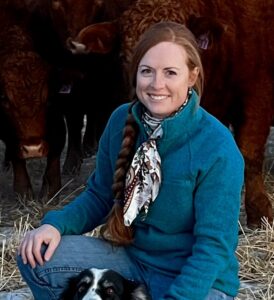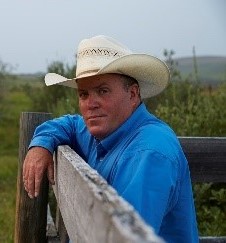Treat Her Like a Cow: Building Fertile, Profitable Heifers
“The more you treat her like a cow, the better cow she will be.” That was one of the standout messages from the Beef Cattle Research Council’s webinar, Raising Heifers for Reproductive Success. Backed by research and on-ranch results, Dr. Elizabeth Homerosky with Veterinary Agri-Health Services and Stephen Hughes of Chinook Ranch in southern Alberta shared practical strategies to develop efficient replacement heifers that are built for longevity and profitability.
The discussion focused on the economics of raising heifers, research-backed development systems, reproductive management and how producers can apply extensive grazing systems to identify the most fertile and efficient females for their herds.
The Cow Value Curve
Dr. Homerosky opened with the concept of the cow value curve, which illustrates how feed costs and depreciation are the top two effects on profitability. An open heifer that leaves the herd before paying for herself contributes heavily to depreciation. Strategies such as marketing cows before their value declines or extending productive longevity help shift this curve in the producer’s favour.
Watch the full webinar recording:
Post-Weaning Heifer Development
Research shows that heifers can be developed to just 50-55% of mature body weight without negatively impacting health or calving ease. The timing and way in which heifers reach this target is key.
Three development systems have been studied:
- Early gain: high-input feeding early, then maintained
- Even gain: steady, moderate gains throughout
- Late gain (extensive systems): early, low-input, compensatory gain on grass
Results show:
- Conception rates were similar, but late gain heifers had 15% more first-cycle pregnancies
- The late gain group also consumed 12% less feed
- Over time, late gain heifers stayed in the herd longer, improving longevity

Why Extensive Systems Work
Extensively managed or late-gain systems may look riskier at first glance, but research shows they can improve conception rates, longevity and overall efficiency.
Extensively managed heifers succeed because they:
- Learn grazing behaviours from their mothers
- Are challenged early, helping identify the most fertile and efficient females
- Take advantage of compensatory gain on grass
- Avoid the setbacks that over-conditioned heifers face
Pre-Breeding and Breeding Management
Once heifers have been developed to target weight, the next step is to prepare them for breeding in a way that sets them up for success long-term.

Six weeks before breeding, best practices include:
- Evaluate cycling and body condition
- “Flush” heifers with spring grass to boost fertility
- Vaccinate with modified live vaccines that carry a fetal protection claim
Research highlights the long-term value of first-cycle pregnancies:
- Heifers calving in the first cycle remain in the herd one year longer on average
- Their calves are consistently heavier at weaning, creating an economic advantage
- Shorter breeding seasons (30-42 days) concentrate first-cycle pregnancies, building herd momentum and profitability
Synchronization and the “Short Cycle” Trick
Estrous synchronization protocols, like 5-Day Co-Synch + CIDR/PRID, can concentrate pregnancies into 30 days. For a more practical system, Dr. Homerosky described the short-cycle trick:
- Bulls are turned out for five days
- Remaining heifers who aren’t pregnant receive prostaglandin (PGF2) to reset their cycle
- By day nine, nearly all heifers have had a chance to conceive
- With bulls left in for 21 more days, producers can achieve ~85% conception in 30 days with minimal handling

Practical Insights from the Ranch
Stephen Hughes of Chinook Ranch shared his experience with year-round grazing and raising efficient females. Key practices include:
- Wintering yearlings with balanced but modest rations to grow frame, not condition
- Sorting heifers by culling the bottom end rather than selecting only the top
- Using a purple tag program to eliminate daughters from cows with undesirable traits
- Keeping heifers past weaning to capture compensatory gain and close the price gap with steers
- Emphasizing short breeding seasons and early preg-checking for efficient selection and marketing
Hughes stressed the cumulative value of “layering and stacking sound management decisions,” from mineral programs to timing of breeding to build a herd of efficient, long-lasting cows.
Take-Home Messages
- First-cycle pregnancies pay dividends in longevity, heavier calves and herd momentum.
- Extensive systems build more fertile, efficient and profitable cows.
- Short breeding seasons drive profitability by increasing selection pressure.
- Treat heifers like cows from the start; efficiency and fertility rise when pampering is avoided.
Both Dr. Homerosky and Hughes emphasized that replacement heifer management should be approached like a profitable grasser operation, with pregnancy as the by-product of efficient grazing and sound management.
LEARN MORE:
- Heifer Development (BCRC topic page)
- Replacement Heifer Calculator (BCRC tool)
- Selecting Replacement Heifers: Boosting Longevity and Return on Investment (BCRC Post)
- Raising Replacement Heifers- What Does it Cost? (BCRC Post)
- Replacement Heifers- Money, Management and Momentum (BCRC Post)
Sharing or reprinting BCRC posts is welcome and encouraged. Please credit the Beef Cattle Research Council, provide the website address, www.BeefResearch.ca, and let us know you have chosen to share the article by emailing us at [email protected].
Your questions, comments and suggestions are welcome. Contact us directly or spark a public discussion by posting your thoughts below.